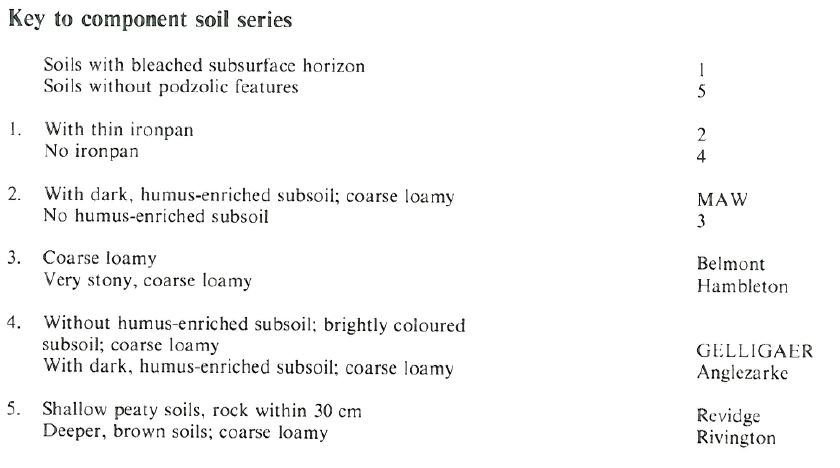
Soil Associations
0652 MAW
Soil and site characteristics
Loamy very acid upland soils over sandstone with a wet peaty surface horizon, often with thin ironpan.
Geology
Carboniferous and Jurassic sandstone
Cropping and Land Use
Wet moorland habitats of poor and moderate grazing value; stock rearing and dairying on improved ground; coniferous woodland.
Component soil series
| Subgroup | Series name | Percentage | WRB 2006 link |
|---|---|---|---|
| 6.52 | MAW | 60% | Placic Endoleptic Histic Stagnic Albic Podzols |
| 6.54 | GELLIGAER | 40% | Endoleptic Histic Stagnic Albic Podzols |
Covers 164 km2 in England and Wales
Soilscapes Classification
| 16 |
Very acid loamy upland soils with a wet peaty surface |
0652 MAW
Detailed Description
This association consists mainly of the Maw series, humus-ironpan stagnopodzols, and the Gelligaer series, ferric stagnopodzols, over Carboniferous or Jurassic sandstones and grits. It is on gentle to moderate dipslopes or long, narrow ridges, mainly between 180 and 260 m O.D. but rising locally to over 450 m O.D. It occurs throughout the North York Moors and in the Pennine foothills of North Yorkshire, under cool, humid, exposed conditions.
The association is commonly found on land rising from lower ground where stagnohumic gley soils of the Onecote and Wilcocks associations predominate, and it merges gradually with the raw peat soils of the Winter Hill association on higher ground. The Maw and Gelligaer series occur together, frequently with the Belmont and Anglezarke series. Locally there are shallow and eroded peat soils. The Revidge series is found wherever rock is close to the surface. Rivington soils are included in areas reclaimed from stagnopodzols or in less exposed places.
Soil Water Regime
Soils are waterlogged for long periods during the growing season (Wetness Class V). The surface is usually wet and does not readily absorb further rainwater so run-off is rapid in winter.
Cropping and Land Use
Unreclaimed heather moorland has little grazing value. Heather (Calluna vulgaris) is usually dominant and bell-heather (Erica cinerea) abundant. There are also wavy hair-grass (Deschampsia flexuosa), other acid-tolerent grasses and a ground layer of Hypnum spp. and other mosses. The wet peaty surface, and a field capacity period of more than 225 days, cause these soils to poach easily and to be inaccessible to machinery in winter. Reclamation is possible by burning the heather, rotavating, subsoiling to break the ironpan, improving fertility and re-seeding, but the severe poaching risk remains. After reclamation the potential yield of grass is large but the land is only marginally suitable for grassland farming, because it can never be densely stocked and stock cannot be out-wintered. However, it can provide good summer pasture where improved.
The association occurs in parts of the North York Moors forests, being suitable for trees once remedial measures have been taken. Deep cultivation is necessary to break the ironpan and improve drainage and aeration. Large stones on the surface hinder machinery. Much of the land is exposed and the rate of tree growth declines above 300 m O.D. The choice of species is restricted to Sitka spruce, Scots pine, hybrid larch and Douglas fir. Heather is likely to re-invade after planting, and there is risk ofFomes attack. Trees, especially Sitka spruce, respond to phosphorus at establishment and during early growth.
0652 MAW
Distribution Map
 |
Note that the yellow shading represents a buffer to highlight the location of very small areas of the association.
Keys to component soil series
Northern Region
 |
Typical Landscapes
Northern Region
 |
Northern Region
 |
All information Copyright, Cranfield University © 2025
Citation: To use information from this web resource in your work, please cite this as follows:
Cranfield University 2025. The Soils Guide. Available: www.landis.org.uk. Cranfield University, UK. Last accessed 25/04/2025
